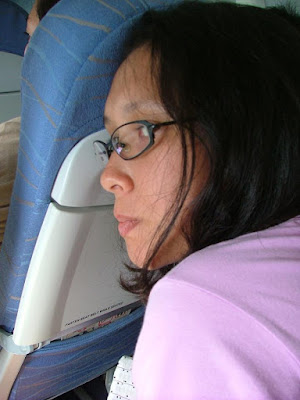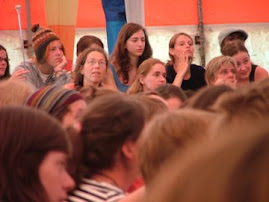[Note: When I was ten to sixteen years old, my family lived in San Jose de Buenavista, Antique, a province located on the island of Panay in the Visayas region. Most of the events I describe in the story happened in high school. “Overdosed” was an exercise I had to do for graduate school to practice describing people and events in detail. May 23, 2005]
I’ve only been to church less than ten times in my whole life and I’ve never given much thought to Jesus. Or Mary. Or the Holy Spirit. Or God for that matter. But then we arrived in San Jose, Antique, and not a week passes by without someone making the sign of the cross or asking me if I am a Christian or if my family goes to mass on Sundays. Now, I hardly notice the questions anymore. That’s because I’m studying in a Catholic school.
It’s already several minutes past three o’clock, and inside the hot classroom, the students are getting restless. Melissa Cabaterno is putting on some more strawberry White Musk, Jill Pacheco is combing her hair for the umpteenth time, and George Reyes is putting on more gel. Donna Mae Azurin is hopping from one noisy group to the next, showing off her new blue-green Swatch watch that her Ninong from the States sent her. At the back, Carlos Jose De Vera strums a guitar while Amadeo Innis, Edwin Braga, and Twinkle Paterno belt out an Eraserheads classic: “Di ba? Lang hiya! Pina-asa niya lang akooooo! Letsyeng pag-ibig to-hohohohohohoo! Diyos ko-hooo!” Shella Soccoro laments loudly, “Taas run akun sungay kay wara ko ka simba kahapon!” (My horns are huge because I wasn’t able to go to mass yesterday!)
I glance at the crucifix above the blackboard and look through the open door across the covered court where Jo Ann Maye Niebres and Willymar de la Cruz are flirting. The lovebirds have finally succumbed to all the teasing. Near the stage, Gilbert Cruz, Ryan Alejandro and John Reyes are checking out the girls in Section Hope. I stop drawing flowers on the blackboard and step outside. The perfumes are stifling. What’s taking my friends so long? I look down the corridor and see Amihan Gonzaga and Rita Bonifacio finally rushing toward our classroom. “May, rugya run si Mr. Trillo!” Ami shouts. (May, Mr. Trillo’s here!) Five seconds later, our Theology teacher appears, his six-foot frame filling the doorway. “Class, please stand up. Who wants to lead the prayer?” he asks. As usual, Eliza Pedrona, our class treasurer, steps forward, faces the class, and says the magic words, “Classmates, let us put ourselves in the presence of the Lord.”
Like clockwork, all stop what they are doing and stand up. “In the name of the Father, and of the Son, and of the Holy Spirit...” The change in atmosphere is striking. Heads are bowed, hands are clasped together, and foreheads wrinkle in concentration. Some close their eyes. “Our Father in heaven, holy be your name, your kingdom come, your will be done on earth as it is in heaven...” Our voices reverberate through the room with such unity and precision, like we’re speaking from the same mouth. In the corner of my eye, I spy Rolita Sorongon praying intently. She is probably thanking God for her perfect score in our math quiz this morning. “Give us this day our daily bread and forgive us our sins as we forgive those who sins against us...” “Sins,” again! It’s supposed to be – “sin”! But nobody seems to notice. “And do not bring us to the test but deliver us from evil, amen.”
“Class, please sit down,” Mr. Trillo says without looking up. From the pile of books that he’s carrying, he chooses the big red one with a mother and child on the cover. He squints and moves the book closer to his eyes so that it covers his entire face, and with his other hand, he scratches his head. One time I counted 10 head scratches in just 30 minutes! He stops scratching and looks down at me like he has heard my thoughts. He puts the book flat on the table and I stare at his bushy eyebrows. They are so thick that they naturally curve at the corners, making him look like Dracula. He smiles and the dimple in his right cheek winks at us.
“Class,” he says, “How was your weekend?” “Fiiiiiine!” the extroverts holler and Mr. Trillo smiles that enchanting smile again. Maybe he does it because he knows that his dimples make him look cute. He turns around and searches for a decent piece of chalk among the nubbins left along the ridge of the blackboard.
Sigh. It’s going to be another long hour about the sacraments and the hierarchy of the church. First come the “laymen,” then the priests, then the bishops, then the cardinals, etc. Why can’t there ever be women priests? The lesson about the Holy Spirit confuses me most. How exactly was it able to make Mary pregnant with Jesus? How was she able to remain a virgin without having had sex? I’m not going to ask these stupid questions of course because I daren’t expose my lack of understanding and get a low grade.
Mr. Trillo finally finds a piece of chalk, he opens the small thin green book with a church on the cover, and starts writing on the blackboard. I wonder what our lesson is going to be about today. Last week, it was about original sin. “Humans are all born sinners,” Mr. Trillo had said, “This is because Adam and Eve, the first man and woman, disobeyed God’s command not to eat from the forbidden apple in the Garden of Eden. Their sin has become humanity’s sin.” And all the while I thought the story of Adam and Eve was just a myth!
Mr. Trillo’s gullibility is such a disappointment sometimes. Does he for instance, really believe that God, like some sort of a magician, created the world in six days? And, heaven and hell and purgatory - are there really such things? Why does everybody call God, “the Father” when “it” is supposed to be sexless? I bet that if the bible had been written in a matriarchal society, Jesus would be a woman and all his apostles would be women, and everybody would be praying to God – “the Mother.”
“Oooh baby I love your way. I wanna be with you night and day.” It’s Mr. Trillo’s phone ringing. He drops the chalk, hurries outside, and closes the door. “Ga? Diin timo run haw?” (Dear? Where are you?) Everybody smirks and eyes roll. Trisha Trillo, Mr. Trillo’s sister, is reading a Sweet Valley High pocketbook, trying to look oblivious. Poor Trisha. And poor us for having teachers who never put their cellphones on silent mode. But that’s typically Saint Angel’s College High School.
I remember that five months ago, I was very excited to study in SAC because mama and papa told me that I’d have to wear a uniform. “Zodat die met weinig kleren niet minderwaardig zullen voelen bij die met veel kleren,” papa explained to me. (So that those who have more clothes won’t make those who own few clothes, feel inferior.) I had to learn the Pambansang Awit and the Panatang Makabayan, among other things. But I had the hardest time getting used to having to pray before and after every subject, joining the Legion of Mary, and going to mass every Sunday because attendance would be checked. It was an endless - sit, stand, respond to priest, sit, respond to priest, sing, kneel, stand! I never imagined church would be this complicated.
Mr. Trillo is still talking on the phone and it’s almost four o’clock. The buzzing in the room is getting louder each second. I skim through my Theology notebook and put my hand on the remaining blank page. It feels cool and smooth. I’m glad I bought a notebook with thick paper so the ink can’t protrude. The last three pages at the end are filled with drawings of black, blue and red flowers with oval petals and leaves. I have to draw each flower in one go - without lifting the pen - otherwise a slight shift will ruin the flow of the ink and I have to start all over again.
The door slams open and I jerk up from my doodling to see Mr. Trillo returning from his chat with his girlfriend. He doesn’t even say sorry for leaving us. “Class, kagahud ba tinyo! Wara lang ko dya isa ka minuto, nagkarambola run mo,” he scolds us. (Class, you’re so noisy! I haven’t been away for one minute and you’re already bouncing off the walls!) I feel like scolding him back for wasting our time. He continues ranting in Kiniray-a and I avoid his angry gaze by keeping mine fixed on his pale blue shirt. I notice the color makes him look younger than his 35 years.
That birthday I remember well because it was the first day of Theology class. After introductions were over, he said, “So, Maya Van-derrr-brooo-ek, you’re from Holland? Your father’s Dutch?” “No sir, he’s a Belgian but we lived in Holland,” I replied, flattered by the attention. Mr. Trillo’s eyes sweep over the room and he says, “Did you know class that in Holland, homosexuals can get married, marijuana is legal, abortion is legal, prostitution is legal, divorce is legal, and euthanasia is legal!” I thought that was a compliment but the shocked expressions on my classmates’ faces told me otherwise.
Mr. Trillo has calmed down and is sitting on top of his desk. He crosses his right foot over his left foot and puts both hands on the table. “Class, do you believe in God?” he asks. What a weird question. Of course, my classmates all believe in God. “Yes, siiiiir!” everyone answers. See? “But how do you know that God exists?” Mr. Trillo prods. “The bible says so! And the bible was written inspired by the Holy Spirit,” Doane Galivero quips. “But what if there is no Bible?” Mr. Trillo persists. Everyone starts talking at the same time and Mr. Trillo seems amused by my classmates’ discomfort. “C’mon class, prove to me that God exists!” he challenges us.
I cannot believe my ears. Is he saying that maybe God does not exist after all? It’s the question that’s been nagging me ever since I entered SAC. For how can we possibly believe in something we cannot see?
“God exists because my mother says so,” Donna Mae tells us. “What if your mother is wrong?” Mr. Trillo says. “Of course not, sir!” Donna Mae frowns. “Mamati gali kaw sa hambal na? Kung magkuon tana na malumpat kaw sa building, malumpat kaw man?” Mr. Trillo teases her. (So you believe everything she says? What if she tells you to jump off a building, will you jump?) Donna Mae opens her mouth, then shrugs and sits down, defeated. “Sir, God exists because he created the world,” Ami says matter-of-factly. Matt Baquero stands up and gestures with his arms like an irritated debater, “Sir, God exists because miracles happen! Miracles happen!” Evohn Nee Batano, who is usually mouse-still, stands up too, and says, “Sir, God exist because there are flowers and trees and birds. Life is proof that God exist!” God “exists” I silently correct her.
“Sir, sir, sir, me, sir! I know the answer!” Rolita is waving her hand in the air and stands up. “God exists because of our FAITH!” she triumphantly declares. “Exactly!” Mr. Trillo claps his hands, “Very good Rolita! God exists because of our FAITH.” Everybody nods and smiles in relief, glad to hear that God exists after all. Then, Mr. Trillo says the most outrageous thing I’ve ever heard a teacher say: “You see class, the Tyrannosaurus Rex, and all those other dinosaurs, NEVER EXISTED. God just put their bones in the earth to TEST OUR FAITH!” I gape at Mr. Trillo. Suddenly, I can’t wait for the summer vacation to begin when I will finally graduate and leave this crazy school forever.
Article Continues...
 a heavy rainfall. The air is cold and the soil is sticky along the banks of the Pangi River in New La Union, Maitum. The water slams against the boulders creating threatening splashes and quickening my heartbeat at the thought of careening down these rapids in an inflated inner tubing of a vehicle or salbabida. The contraption looks like a gigantic doughnut with flat rope webs converging in the middle of the hole.
a heavy rainfall. The air is cold and the soil is sticky along the banks of the Pangi River in New La Union, Maitum. The water slams against the boulders creating threatening splashes and quickening my heartbeat at the thought of careening down these rapids in an inflated inner tubing of a vehicle or salbabida. The contraption looks like a gigantic doughnut with flat rope webs converging in the middle of the hole.


































